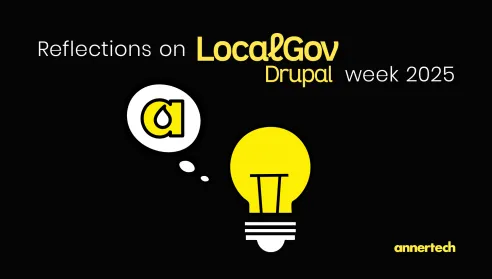Microsites – five practical uses for these versatile, easy websites

Organisations can manage their entire digital portfolio with this one installation: LocalGov Drupal Microsites.
Making the management of multiple websites easier
Managing multiple websites can be tricky, especially if they’re published across various platforms, with different log-ins and content management systems.
It’s not just logging in and maintaining the various sites that can be challenging, it’s also ensuring brand consistency and regulatory compliance across the various platforms. It’s much easier to work on one system where all the sites are accessible and visible.
The Microsites platform, which was created by LocalGov Drupal, is a stand-alone system that offers organisations control of their entire digital estate as opposed to having many individual sites with different systems and functionalities.
The term “microsites”, especially the use of the word “micro”, can be misleading. What it essentially refers to is a fleet of websites (usually with the same design system) owned and operated by one entity.
Microsites are usually needed by organisations that need more than one site – such as councils, colleges, multinationals – all of which need to identify with the parent organisation in terms of brand identity but need to be separate and are flexible in terms of their look and feel.
What’s the link with LocalGov Drupal?
LocalGov Drupal is a platform that allows local governments to create the best websites possible as quickly as possible by sharing code and saving money. It is essentially designed by councils for councils.
As it is an open source CMS, it is freely available and so any additional digital budgetary allocation can go towards building features or services that haven’t been developed yet.
Although there are loads of features available to councils who use the LocalGov Drupal CMS, one big one kept coming up – councils needed microsites that are easy to set up and manage, and also easy to shut down if needs be.
The new Microsites platform was the response to this call for such a feature. It’s a stand-alone system that is based on the LocalGov Drupal CMS, but isn’t married to it, and allows a single installation to run many individual sites.
Digital teams can quickly, cheaply and easily create multiple, distinct, websites that are easily updated and maintained. Each site has its own distinct users, content, files and domain, and can be customised to suit its needs.
Features of the Microsites platform
- One installation: The new LocalGov Drupal Microsites platform allows organisations or businesses to have complete control of their digital portfolio with one, easy-to-use installation.
- Centralised Control: The Microsites platform allows a single site to run many individual sites, all easily updated and maintained by one, or more, digital teams.
- Flexibility: Although many of an organisation’s microsites may have the same design, the platform is so flexible that any individual microsite can have a custom design if they wish.
- Easy to manage: The platform uses a single code and database. Only one site is needed to host and maintain all the microsites so it saves time. Yet different teams can edit individual sites if needed. However, where teams manage multiple microsites, their access details are the same.
- Features: The Microsites platform has an excellent content editor experience. The platform contains an impressive set of features so content editors can create unique, stand-out content. Each site can be configured to use a certain set of colours and typography. The platform is also set up to allow a bespoke theme to be set on a site-by-site basis.
Microsites are not only for councils
In various organisations, many digital teams find themselves supporting numerous websites across departments and services.
These sites often share functionality, but each site is created from scratch and is often maintained by a third party.
Organisations spend considerable money, time and energy ensuring these sites are secure, up-to-date, accessible and valuable. The microsites platform uses a single code and database, needing only one site to host and maintain all your microsites, with a controller who has oversight of all the websites.
Here are some examples of how organisations could use microsites to their advantage:
1. Universities
A university is typically a large organisation, with many faculties and departments.
Microsites could offer each department or faculty the freedom to manage their own “website”, and give it a uniform look, feel, and feature set within the branding guidelines of the university.
2. Political Parties
A political party could organise itself by province or by county, each with their own website that follows brand guidelines but focuses on grass-roots level problems within a smaller area.
Or each public representative could have their own microsite, that contains news of their particular projects, interests or areas in which they operate.
The political party could even have sites that reflects its policies – for example a site that focuses on a specific education campaign, or one that has information about proposed green areas or cycle lanes.
3. Multinationals
Large companies that operate across various continents can find their website needs challenging. Each of the branches or divisions of the company may have its own website, sometimes developed by different agencies, sporting very different looks even though they’re part of the same company.
With microsites, it is possible to build a style guide as a base that is used for every site. So even though each site can be individually managed, with separate log-ins, they can retain the branding of the parent company while being customised to suit the needs of the individual divisions or branches.
4. City or County Councils
Councils have various community events that might not have council branding. Or it could need a website for a specific services, such as elections, fostering services or recycling, for example. Each microsite could have its own distinct users, content, files and domain.
These are, for example, events such as a St Patrick’s Day festival, where the website is separate from a council’s main website, and may also be seasonal. When the site has run its course, it can be shut down quickly and efficiently.
5. Sports Bodies
Take any sports body, such as Irish Rugby or the Gaelic Athletic Association. These bodies have hundreds of clubs under their banner.
Instead of each club in the country having their own website, the microsite platform offers them the freedom of developing their own, with many features, while allowing for differences in appearance between clubs and yet still following the guidelines set out by the parent body.
Should a club want a different design, they can override the colours – each site is customisable so they don’t have to have the same look and feel.
Conclusion
Although the Microsite platform was developed for LocalGov Drupal, it is a standalone product and the main website doesn’t not have to be built on LocalGov Drupal to take advantage of the Microsite offering.
This platform offers organisations a quick and easy way to bring all their websites and future microsites into one manageable instance that reduces costs and risk.
You can see the features that are available and also a demo of the new microsites platform on the LocalGov Drupal website.

Could you use the Microsite project?
If you’re interested in the freedom and flexibility of the Microsite offering, we’re happy to walk you through the platform.



